| Using ArcToolbox
ArcToolbox is a set of utilities that is available for users to
do a variety of tasks from conversion of file types to spatial analyses.
ArcToolbox utilities are available directly within ArcMap starting
with ArcGIS 9.x. In this workshop we will only look at importing
ArcInfo export files and setting/changing projection information.
ArcToolbox can be opened by clicking on the toolbox ( ) or by selecting it from the Start>Programs menu.
) or by selecting it from the Start>Programs menu.
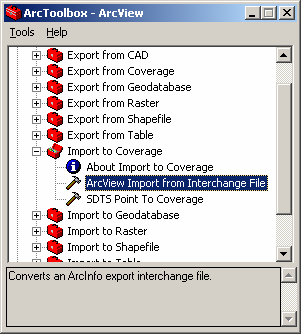
Importing ArcInfo export (E00) files
ArcInfo export files, with the extension .E00, are used by most
groups to transfer ArcInfo data from one location to another. These
file contain ArcInfo coverages. A coverage file is a special group
of files used by ArcInfo. An ArcInfo coverage can contain more than
one class of features. A polygon feature may also contain line features
(arc) which store information about the boundaries between each
polygon. To the user looking at the coverage file from Windows,
coverages appear to be made up of two directories - the coverage
directory (e.g. hr46) and an information directory (info). The group
of files make up an ArcInfo coverage and includes a wide range of
information including label points, polygons, lines (that make up
the polygons), ticks, network information, projection, etc... Because
coverage files are made of multiple parts they are not easy to transfer
between systems so data providers create an ArcInfo export files
when they want to move a coverage. Generally you will want to use
ArcCatalog to move and edit GIS data sources.
Most ArcInfo files that are available on the WWW or through the
DLI (Data Liberation Initiative) are in ArcInfo export format (E00).
These files have to be imported or converted from the single file
export format to the multiple file coverage. When you open an imported
coverage file, two new directories will automatically be created
– the coverage directory and the information directory.
The import program used to convert ArcInfo export files back into
coverages is run from ArcToolbox by selecting Import to Coverage
> ArcView Import from Interchange File.

Because coverage files are made of multiple parts you will need
to open just the part of interest. When viewing a coverage file
from within ArcMap, Add Data or in ArcCatalog it will appear to
have multiple parts (polygon, arc, annotation, label, point etc.).
Many CAD files will show up in a similar fashion.
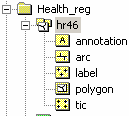
Under ArcGIS 9 a number of the conversion tools that were part
of the regular tool box have been moved.
ARC/Info Interchange (Export) Format: This format,
whose extension is usually .e00, will need to be translated into
ARC/Info coverages. In version 9.x, access the the conversion utility
by opening ArcCatalog and from the View menu add the "ArcView
8x Tools" toolbar. This also provides access to utilities to
convert from MapInfo or SDTS (Spatial Data Transfer Standard) files,
among others.
Adding/Changing Projections
If you know the projection or type of data that is contained in
a shape file but it does not appear correctly with other shape files
it is often useful to define the projection. This will allow ArcGIS
to recognize the file and, within some limits, display multiple
geographic data sources that are stored in different projections.
Inside ArcToolbox select Data Management-> Projections ->
Define Projection Wizard (shapefiles, geodatabase). Select the Health
Canada RHA shape file saved from the hr46 coverage polygons. You
might get a warning that a projection has already been defined.
Click on the ‘Select Co-ordinate System’ button and
Import the co-ordinate system used by the hr46 coverage file. If
you know all of the projection information you can assign this by
hand but by taking a quick look at the data fields you will quickly
see this can be quite complex.
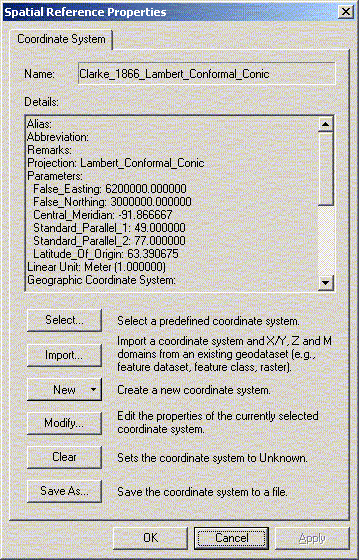
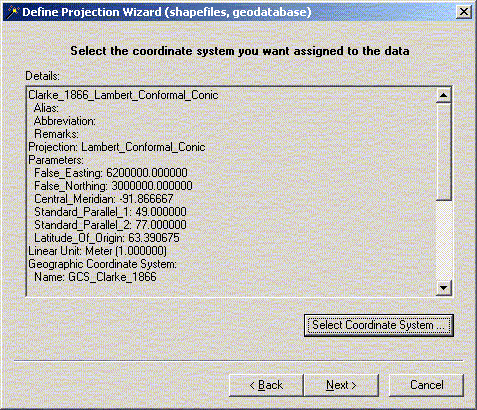
Most of the data at the centre is stored in decimal degrees and
can have the projection information set as North American Datum
1927 (Geographic Co-ordinate Systems -> North American ->
North American Datum 1927). Geographic data associated with the
2001 census and most other sources can be assigned to North American
Datum 1983 or WGS84.
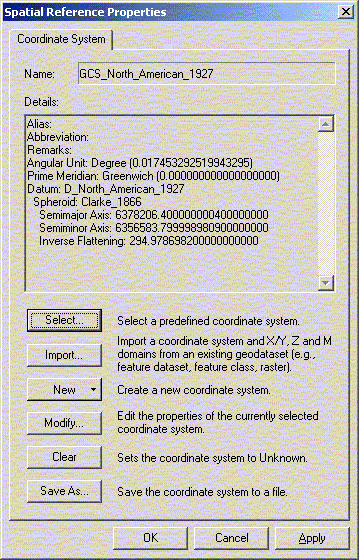
 Introduction
Introduction
 ArcCatalog: Basic Uses
ArcCatalog: Basic Uses |
NEXT
 Adding Spatial Information: Georeferencing
Adding Spatial Information: Georeferencing |
| 